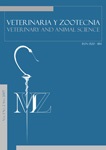Autores/as
Resumen
RESUMEN: Los músculos intrínsecos del miembro torácico presentan su origen e inserción en los huesos y/o fascias propias del miembro. Los músculos del hombro y brazo de primates presentan variabilidad intraespecífica, interespecífica e incluso en los miembros colaterales de un mismo espécimen. Por otro lado, hay algunos músculos que no presentan diferencias importantes entre primates como el supraespinoso y el infraespinoso. La importancia de conocer estas variabilidades y similaridades entre primates, es que el médico veterinario las podrá tener en cuenta al realizar un abordaje quirúrgico en estas regiones. El presente estudio revisa los orígenes e inserciones de los músculos intrínsecos del hombro y brazo de primates, presentando un análisis al final de cada región, y en la última parte del artículo establece propuestas de investigación en anatomía de primates no humanos.
Citas
Aversi-Ferreira, T.A.; Pires, R.; Da Silveira, P. et al. Anatomía dos músculos extensores superficiais do antebraço do macaco Cebus. International Journal of Morphology, v.23, n.1, p.45-94, 2005a.
Aversi-Ferreira, T.A.; Aversi-Ferreira, R.A.G.M.F.; Silva, Z. et al. Estudo anatômico de músculos profundos do antebraço de Cebus apella (Linnaeus, 1766). Acta Scientiarum – Biological Sciences, v.27, p.297-301, 2005b.
Aversi-Ferreira, T.A.; Lima-e-Silva, M.S.; Pereira-de-Paula, J. et al. Anatomia comparativa dos nervos do braço de Cebus apella. Descrição do músculo dorsoepitroclear. Acta Scientiarum –Biological Sciences, v.27, p.291-296, 2005c.
Aversi-Ferreira, T.A.; Vieira, L.G.; Pires, R.M. et al. Estudo anatómico dos músculos flexores superficiais do antebraço no macaco Cebus apella. Bioscience Journal, v.22, p. 139-144, 2006.
Aversi-Ferreira, T.A.; Pereira-de-Paula, J.; Prado, Y.C.L. et al.Anatomy of the shoulder and arm muscles of Cebus libidinosus. Brazilian Journal of Morphological Science, v.24, n.2, p.3-14, 2007.
Aversi-Ferreira, T.A.; Diogo, R.; Potau, J.M. et al. Comparative anatomical study of the forearm extensor muscles of Cebus libidinosus (Rylands et al., 2000; Primates, Cebidae), modern humans, and other primates, with comments on primate evolution, phylogeny, and manipulatory behavior. Anatomical Record-Advances in Integrative Anatomy and Evolutionary Biology, v.293, p.2056-2070, 2010.
Aversi-Ferreira, T.A.; Maior, R.S.; Carneiro-e-Silva, F.O. et al. Comparative anatomical analyses of the forearm muscles of Cebus libidinosus (Rylands et al. 2000): manipulatory behavior and tool use. PLoS ONE, v.6, n.7, 2011. Disponible en: http://www.plosone.org/article/info%3Adoi %2F10.1371%2Fjournal.pone.0022165 Accesado en: 15/10/2011.
Champneys, F. On the muscles and nerves of a chimpanzee (Troglodytes niger) and a Cynocephalus anubis. Part I. Journal of Anatomy & Physiology, v.6, n.1, p.176-211, 1871.
Cribillero, N.; Sato, A.; Navarrete, M. Anatomía macroscópica de la musculatura del miembro anterior del mono machín blanco (Cebus albifrons). Revista de Investigaciones Veterinarias del Perú, v.20, n.2, p.143-153, 2009.
Defler, T.R. Historia natural de primates neotropicales. 2ª ed. Bogotá, Colombia: Universidad Nacional de Colombia, Facultad de Ciencias, Departamento de Biología, 2010. 612p.
Diogo, R.; Abdala, V. Muscles of vertebrates: Comparative anatomy, evolution, homologies and development. USA: Science Publishers, 2010. 481p.
Diogo, R.; Richmond, B.G.; Wood, B. Evolution and homologies of primate and modern human hand and forearm muscles, with notes on thumb movements and tool use. Journal Human Evolution, v.63, n.1, p.64-78, 2012.
Drake, R.L.; Vogl, W.; Mitchel, A.W.M. Gray: Anatomía para estudiantes. 1a ed. España: Elsevier, 2005. 1058p.
Dyce, K.M.; Sack, W.O.; Wensing, C.J.G. Anatomía veterinaria. 4ª ed. México: El Manual Moderno, 2011. 852p.
Evans, H; De Lahunta, A. Miller’s anatomy of the dog. 4a ed. China: Saunders Elsevier, 2013. 850p.
Federative International Committee on Anatomical Terminology (FICAT). International Anatomical Terminology. New York: Thieme Medical Publishers, 1998. 292p.
Gray, H.; Standring, S. Gray’s Anatomy: The anatomical basis of clinical practice. 40 ed. Churchill Livingstone: Elsevier, 2008. 1576p.
Groves, C.P. Order Primates. In: Wilson, D.E.; Reeder, D.M. Mammal Species of the World. USA: The Johns Hopkins University Press, 2005. p.111-184.
Hepburn, D. The comparative anatomy of the muscles and nerves of the superior and inferior extremities of the anthropoid apes. Journal of Anatomy Physiology, v.26, n.1, p.149-186, 1892.
Howell, B.; Straus, W. The brachial muscles in primates. Proceedings U. S. National Museum, v.80, p.1-31, 1932.
International Committee on Veterinary Gross Anatomical Nomenclature (ICVGAN). Nomina Anatomica Veterinaria. 5a ed.(revised version). Hannover:ICVGAN,2012. 177p.
Kardong, K. Vertebrates: Comparative anatomy, function, evolution. 6a ed. New York: McGraw-Hill, 2011. 794p.
Kimura, K.; Takai, S. On the musculature of the forelimb of the crabeating monkey. Primates, v.11, n.2, p.145-170, 1970.
Langman, S. Embriología médica. 10ª ed. Buenos Aires: Médica Panamericana, 2007. 386p.
Lima, M.O.; Vieira, L.G.; Ribeiro, P.R.Q. et al. Morphology of the shoulder muscles in Sapajus apella (Primates: Cebidae). Biotemas, v.26, n.1, p.129-135, 2013.
Michilsens, F.; Vereecke, E.E.; D’Août, K. et al. Functional anatomy of the gibbon forelimb: adaptations to a brachiating lifestyle. Journal of Anatomy, v.215, n.3, p.335-354, 2009.
Osman-Hill, W.C. The Anatomy of Callimico goeldii (Thomas). Transactions of the American Philosophical Society, v.49, n. 5, p.1- 116, 1959.
Perelman, P.; Johnson, W.E.; Roos, C. et al. A molecular phylogeny of living primates. PloS Genetics, v.7, n.3, e1001342, 2011.
Primrose, A. The anatomy of the orang outang. Toronto: University Library, 1900. Disponible en: http://www.archive.org/details/cihm_14732 Accesado en: 15/10/2011.
Quevedo, U.M.; Cisneros, S.J.; Navarette, Z.M. et al. Descripción anatómica de los músculos del miembro posterior y cola del mono machín blanco (Cebus albifrons). Revista de Investigaciones Veterinarias del Perú, v.20, n.2, p.165-170, 2009.
Schmidt, M.; Schilling, N. Fiber type distribution in the shoulder muscles of the tree shrew, the cotton-top tamarin, and the squirrel monkey related to shoulder movements and forelimb loading. Journal of human evolution, v.52, n.4, p.401-419, 2007.
Sinowatz, F. Musculo-skeletal system. In: Hyttel, P.; Sinowatz, F.; Vejlsted, M. (eds.). Essentials of domestic animal embryology. Oxford: Saunders Elsevier, 2010. p.286-316.
Stevens, J.L.; Meyer, D.M.; Edgerton, V.R. Gross anatomy of the forelimb and shoulder girdle of the Galago senegalensis. Primates, v.18, n.2, p.435-452, 1977.
Stevenson, P.R.; Guzmán, D.C.; Defler, T.R. Conservation of colombian primates: An analysis of published research. Tropical Conservation Science, v.3, n.1, p.45-62, 2010.
Youlatus, D. Functional anatomy of forelimb muscles in Guianan Atelines (Platyrrhini: Primates). Annales des sciences naturelles, v.21, n.4, p.137-151, 2000.
Vélez-García, J.F.; Cobo-Ángel, C.; Varón-Álvarez, L. Fijaciones de la musculatura intrínseca del hombro y brazo de primates. Veterinaria y Zootecnia, v.7, n.1, p.8-20, 2013.

 PDF
PDF
 FLIP
FLIP










